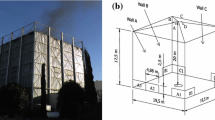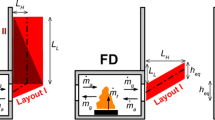Abstract
In order to mitigate the excessive computational cost of atrium fire simulations, a novel methodology based on the use of the Fractional Factorial Design technique to obtain an experimental validated tool, in the form of a surface response model, capable to predict fire induced conditions is proposed. This methodology is supported by results from a Design of Experiments benchmark, which consists of a set of FDS simulations in the present work. Specifically, a \(2^{6-2}_{IV}\) approach has been considered and applied to a 20 m cubic atrium. Thus, six factors have been considered, namely the fire Heat Release Rate (HRR) and location, the exhaust flow rate, the exhaust location and activation time, and the inlet vents area. Furthermore, the smoke temperature at the roof and 15 m high and the smoke layer height have been considered the variables of interest. Subsequently, a multiple linear regression analysis has been performed to predict and compare the steady and non-steady temperature profiles and the smoke layer drop with six novel full-scale atrium fire tests, and also with specific adjusted FDS models. In addition, this methodology has been extended successfully to predict the non-steady behaviour of the fire tests. At the steady state, the HRR and the exhaust flow rate have been found to be the most relevant factors. The results obtained with the proposed methodology show a good fit both with the fire tests and with the adjusted FDS models, with discrepancies mostly below 14%. For non-steady conditions, a time analysis of the influence of the six factors has been carried out. Again, remarkable good agreement with the time-dependent experimental results is achieved, with average discrepancies below 12%, being the larger differences found in the prediction of local effects, such as the smoke ceiling jet, for high HRR or when the make-up air influence is significant. The results turn this methodology into a powerful and useful tool for fire safety designs.








Similar content being viewed by others
References
NFPA-92B (2005) Guide for smoke management systems in atria, covered malls, and large areas, 2005th edn. National Institute of Standard and Technology, Quincy
Tilley N, Merci B (2009) Application of FDS to adhered spill plumes in atria. Fire Technol 45(2):179–188. doi:10.1007/s10694-008-0079-z
Kerber S, Milke JA (2007) Using fds to simulate smoke layer interface height in a simple atrium. Fire Technol 43(1):45–75. doi:10.1007/s10694-007-0007-7
Milke JA (1990) Smoke management for covered malls and atria. Fire Technol 26(3):223–243. doi:10.1007/BF01040110
Box G, Hunter J, Hunter W (2005) Statistics for experimenters: design, innovation, and discovery, 2nd edn. Wiley, Hoboken
Suard S, Hostikka S, Baccou J (2013) Sensitivity analysis of fire models using a fractional factorial design. Fire Saf J 62:115–124. doi:10.1016/j.firesaf.2013.01.031 special Issue on PRISME Fire Safety in Nuclear Facilities
Sullivan PJ (2004) A probabilistic method of testing for the assessment of deterioration and explosive spalling of high strength concrete beams in flexure at high temperature. Cement Concr Compos 26(2):155–162. doi:10.1016/S0958-9465(03)00088-X
Peacock RD, Reneke PA, Forney C, Kostreva MM (1998) Issues in evaluation of complex fire models. Fire Saf J 30(2):103–136. doi:10.1016/S0379-7112(97)00061-1
Kneeshaw K, Vaske J, Bright A, Absher J (2004) Situational influences of acceptable wildland fire management actions. Soc Nat Resour 17(6):477–489. doi:10.1080/08941920490452427
Floyd J, Forney G, Hostikka S, Korhonen T, McDermott R, McGrattan K (2013) Fire dynamics simulator (version 6), technical reference guide. NIST Special Publication 1018-5, National Institute of Standards and Technology, Gaithersburg
Gutiérrez-Montes C, Sanmiguel-Rojas E, Kaiser AS, Viedma A (2008) Numerical model and validation experiments of atrium enclosure fire in a new fire test facility. Build Environ 43(11):1912–1928
Gutiérrez-Montes C, Sanmiguel-Rojas E, Viedma A, Rein G (2009) Experimental data and numerical modelling of 1.3 and 2.3 mw fires in a 20 m cubic atrium. Build Environ 44(9):1827–1839
Gutiérrez-Montes C, Sanmiguel-Rojas E, Viedma A (2010) Influence of different make-up air configurations on the fire-induced conditions in an atrium. Build Environ 45(11):2458–2472
Ayala P, Cantizano A, Rein G, Vigne G, Gutiérrez-Montes C (2016) Fire experiments and simulations in a full-scale atrium under transient and asymmetric venting conditions. Fire Technol 52(1):51–78. doi:10.1007/s10694-015-0487-9
Hostikka S, Kokkala M, Vaari J (2001) Experimental study of the localized room fires nfsc2 test series. VTT TIEDOTTEITA
Ayala P, Cantizano A, Gutirrez-Montes C, Rein G (2013) Influence of atrium roof geometries on the numerical predictions of fire tests under natural ventilation conditions. Energ Build 65:382–390. 10.1016/j.enbuild.2013.06.010, http://www.sciencedirect.com/science/article/pii/S0378778813003484
Montgomery DC, Runger GC (2003) Applied Statistics and Probability for Engineers, 3rd edn. Wiley, New York
Stigler S (2008) Fisher and the 5 % level. Chance 21(4):12–12
MATLAB (2011) version 7.13 (R2011b), 1st edn. The MathWorks Inc., United States
Babrauskas V, Peacock RD (1992) Heat release rate: the single most important variable in fire hazard. Fire Saf J 18(3):255–272. 10.1016/0379-7112(92)90019-9, http://www.sciencedirect.com/science/article/pii/0379711292900199
Heskestad A, Hovde PJ (1994) Assessment of smoke production from building products. Fire Saf Sci 4:527–538
Bwalya A (2008) An overview of design fires for building compartments. Fire Technol 44(2):167–184. doi:10.1007/s10694-007-0031-7
Babrauskas V (2016) Heat release rates. 10.1007/978-1-4939-2565-0_26, http://www.scopus.com/inward/record.url?eid=2-s2.0-84956993072&partnerID=40&md5=683f770b17f149690a228e431141f073
Mowrer FW (2002) Enclosure smoke filling and management with mechanical ventilation. Fire Technol 38(1):33–56. doi:10.1023/A:1013476730932
Chow W, Yi L, Shi C, Li Y, Huo R (2005) Experimental studies on mechanical smoke exhaust system in an atrium. J Fire Sci 23(5):429–444
Lougheed GD, Hadjisophocleous GV, McCartney C, Taber BC (1999) large-scale physical model studies for an atrium smoke exhaust system. Ashrae Trans 105(1):1–23
Gutierrez-Montes C, Sanmiguel-Rojas E, Burgos M, Viedma A (2012) On the fluid dynamics of the make-up inlet air and the prediction of anomalous fire dynamics in a large-scale facility. Fire Saf J 51:27–41. doi:10.1016/j.firesaf.2012.02.007
Acknowledgments
This work has been supported by the Spanish MINECO, Subdireción General de Gestión de Ayudas a la Investigación, Junta de Andalucía and European Funds under projects DPI2014-59292-C3-3-P and P11-TEP7495.
Author information
Authors and Affiliations
Corresponding author
Rights and permissions
About this article
Cite this article
Ayala, P., Cantizano, A., Sánchez-Úbeda, E.F. et al. The Use of Fractional Factorial Design for Atrium Fires Prediction. Fire Technol 53, 893–916 (2017). https://doi.org/10.1007/s10694-016-0609-z
Received:
Accepted:
Published:
Issue Date:
DOI: https://doi.org/10.1007/s10694-016-0609-z




